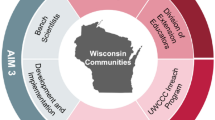Abstract
This study presents a qualitative evaluation of the Avon Foundation Community Education and Outreach Initiative (CEOI) Patient Navigation Program. Qualitative in-depth interviews were conducted with breast cancer patients (N = 18) of the CEOI Patient Navigation Program. Primary strengths of the program include the nature of the relationship between the patient and navigator, the availability of navigators to attend appointments, and the fact that navigators were breast cancer survivors. The process of enrolling patients into the program was a weakness. Participants described positive experiences with this program. They also identified areas of improvement that are relevant to other patient navigation programs in the US.
Similar content being viewed by others
References
American Cancer Society (2007) Breast cancer facts & figures 2007–2008. American Cancer Society, Atlanta
Centers for Disease Control and Prevention (2007) 2006 Women’s health behavioral risk factor surveillance system prevalence data. Behavioral Risk Factor Surveillance System. Available at http://apps.nccd.cdc.gov/BRFSS/display.asp?cat=WH&yr=2006&gkey=4421&state=GA. Accessed 1 July 2008
Freeman HP, Chu K (2005) Determinants of cancer disparities: barriers to cancer screening, diagnosis, and treatment. Surg Oncol Clin N Am 14(4):655–659
Lantz PM, Mujahid M, Schwartz K et al (2006) The influence of race, ethnicity, and individual socioeconomic factors on breast cancer stage at diagnosis. Am J Public Health 96(12):2173–2178
Lund MJ, Brawley OP, Ward KC, Young JL, Gabram SGA, Eley JW (2007) Parity and disparity in first course treatment for invasive breast cancer among black and white women in Atlanta. Breast Cancer Res Treat 109:545–557
Freeman HP (2004) Poverty, culture, and social injustice: determinants of cancer disparities. CA Cancer J Clin 54:72–77
Corbie-Smith G, Thomas SB, Williams MV, Moody-Ayers S (1999) Attitudes and beliefs of African Americans toward participation in medical research. J Gen Intern Med 14:537–546
Corbie-Smith G, Thomas SB, St George DM (2002) Distrust, race, and research. Arch Intern Med 162:2458–2463
Shavers-Hornaday VL, Lynch CF, Burmeister LF, Torner JC (1997) Why are African Americans under-represented in medical research studies? Impediments to participation. Ethn Health 2:31–45
Freeman HP (2006) Patient navigation: a community based strategy to reduce cancer disparities. J Urban Health 83(2):139–141
Freeman HP, Muth BJ, Kerner JF (1995) Expanding access to cancer screening and clinical follow-up among the medically underserved. Cancer Pract 3(1):19–30
Earp JA, Eng E, O’Malley et al (2002) Increasing use of mammography among older, rural African American women: results from a community trial. Am J Public Health 92:646–654
Gary TL, Bone LR, Hill MN et al (2003) Randomized controlled trial of the effects of nurse case manager and community health worker interventions on risk behaviors for diabetes-related complications in urban African Americans. Prev Med 37:23–32
Kegler MC, Malcoe LH (2004) Results from a lay health advisor intervention to prevent lead poisoning among rural Native American children. Am J Public Health 4:1730–1735
Dohan D, Schrag D (2005) Using navigators to improve care of underserved patients. Cancer 104(4):848–855
Freeman HP (2006) Patient navigation: a community centered approach to reducing cancer mortality. J Cancer Educ 21(suppl):S11–S14
Patton MQ (1990) Qualitative evaluation and research methods. Sage, Beverly Hills
Acknowledgements
This study was supported by the Avon Foundation Breast Cancer Crusade.
Author information
Authors and Affiliations
Corresponding author
Rights and permissions
About this article
Cite this article
Schlueter, D.F., Thompson, W.W., Mason, T.A. et al. A Qualitative Evaluation of the Avon Foundation Community Education and Outreach Initiative Patient Navigation Program. J Canc Educ 25, 571–576 (2010). https://doi.org/10.1007/s13187-010-0073-2
Published:
Issue Date:
DOI: https://doi.org/10.1007/s13187-010-0073-2




